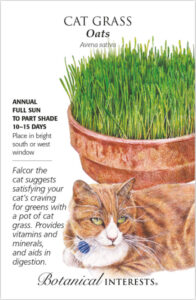It will most likely be gone by the time anyone reads this article, but right now my garden is covered with a couple of inches of fresh snow. I haven’t put out any purchased bird seed yet this morning, but in the meantime there are plenty of birds in my yard nibbling on the seed heads of many plants that I have left standing as sources of winter food. Some of the seeds being consumed are from native wildflowers which I grow in order to enhance the utility of our garden as a habitat for beneficial insects and birds. Other seeds are from useful plants that I grow for different purposes, one of which is Oats, Avena sativa.

At Schnarr’s we sell Botanical Interests brand seeds which packages Oats as “Cat Grass”. In the past I have made extensive use of Oats as a cover crop. I was able to order from Schnarr’s a large sack packaged as “Race Horse Oats”. The Oats contained within were viable seeds and grew very well for me as a cool-season cover crop. As the Oat plants matured and produced seed, I noticed their popularity with wild birds and enjoyed the extra benefit of attracting more winged visitors in my garden.
Oats are often green at times of the year when you need something besides brown in the garden (“Cat Grass…”), so they are useful to keep in mind as an option when planning the seasonal succession of plants in your garden. However, they might not be suited to every garden. In some regions they have been reported as invasive (“Cat Grass…”) and although the dried stalks are very pretty as they arch over the garden with a full head of golden seeds, animals quickly rough up the patch trying to get at them so unfortunately the plants don’t stay pretty for very long once they are ripe.
When Oat plants finish their life cycles, they dry out and produce straw. Straw potentially has many uses in the garden such as mulch, a soil amendment, or if it’s made into bales, a growing medium. The hollow straw Oats produce is also a great material for filling houses designed as nesting sites for pollinating peaceful native bees.

Last summer my husband and I installed a small pond. We’re still working on parts of the system, especially the aesthetics, but the filters and waterfall have been functional for many months now. We’ve had a pretty mild winter overall, so on many days when it’s not freezing I’m able to run one of the filters that directs its outflow water to our small waterfall where it is further filtered with lava rock and, in season, plants as the flow trickles back down to the main section of the pond system.
In that short video above, you can see that I have bundles of floating straw in the filter. Many people are familiar with the use of Barley straw in ponds to prevent excess algae growth. I did a little research to find out if I could use Oat straw as a substitute, and although it may not be quite as effective as Barley, Oats can indeed be used as an algae treatment (Poole).

The straw algae treatment is more effective as a prevention than as a cure, so adding it before there is a visible algae problem is an advantage. If you have Oat straw or other straw available, try tying it in bundles to add to your pond – right now is a great time, if you’re looking for a winter task you can do for your garden. The straw looses effectiveness after a few months, so you can also use some of your winter gardening “down time” to make extra bundles for use later in the season.
Works Cited and Further Reading
“Avena sativa L.” United States Department of Agriculture, 2021, plants.usda.gov/core/profile?symbol=AVSA. Accessed 28 January 2021.
“Cat Grass, Common Oat, Wild Oat.” Dave’s Garden, 2021, davesgarden.com/guides/pf/go/62227/. Accessed 28 January 2021.
Poole, Terri. “Controlling Pond Algae With Straw.” Turfgrass Matters, May 5, 1996 p. 5. archive.lib.msu.edu/tic/matnl/article/1996may5.pdf. Accessed 28 January 2021.
Rust, Kenneth. “Spring Pond Algae Invasion.” Ogden Publications, Inc., 2014, www.motherearthnews.com/homesteading-and-livestock/pond-spring-algae-invasion-zbcz1404. Accessed 28 January 2021.
Winkelmann, Carolyn Hasenfratz. “Help – My Pond is Full of Algae!” Schnarr’s Hardware Company, 2017, schnarrsblog.com/help-my-pond-is-full-of-algae/. Accessed 28 January 2021.